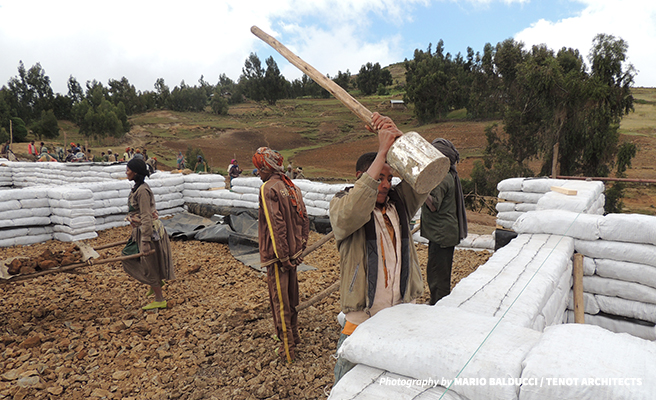Linking Conservation and Education

Today, March 3, is World Wildlife Day—a recognition of the need to protect the many wildlife species with whom we share the planet. This year’s theme: “Listen to the young voices.” With nearly 25 percent of the global population between the ages of 10 and 24, young people have a significant role to play in protecting endangered wildlife—now and in the future.
For quite some time, AWF has been working to develop the next generation of African conservationists. Most recently, this has been done through our Classroom Africa program. In many of the rural places where AWF works, students do not have access to the same quality of education as their urban counterparts.
Classroom Africa works to rectify that problem, while also weaving in an appreciation of conservation from an early age: The program builds and provides long-term support to primary schools in exchange for communities’ commitments to participating in specific conservation activities.
A better learning environment
Ethiopia’s Simien Mountains National Park is one of the landscapes where AWF is implementing our Classroom Africa program—among other conservation interventions. The park is a World Heritage Site in Danger where human encroachment into the protected area represents the main threat.
AWF came to an agreement with the Adisge community—located on the outskirts of the park—that these families would refrain from farming, grazing livestock or poaching park wildlife, among other activities.
In return, AWF rebuilt the run-down Adisge Primary School to create a better learning environment for its students.
After more than a year of hard work, construction on the new school is wrapping up. The previous school had accommodated only grades 1 through 6, forcing older students to go elsewhere to complete their primary education. With the closest school offering grades 7 and 8 a staggering 12 km away, most students never ended up finishing their schooling. The new campus features a number of classroom blocks that fully accommodate students through grade 8.
Given the altitude, the weather in Adisge is often windy and cold, and the classrooms were similarly chilly. Teachers used to close the windows to retain heat, with the result being dark, dank classrooms.
The rebuilt Adisge school was constructed with earth bags—sacks filled with soil from the construction site—which were then stacked like bricks to create the core walls of the school. Much thicker than typical cinderblock construction, the earth-bag walls provide excellent insulation and keep the classrooms comfortable. A light-colored lime-and-cement mixture plastered over the earth bags ensures smooth walls and bright classrooms, while the roofing design allows for ample natural light and ventilation.

Incorporating conservation into education
Equipped with a bright, comfortable learning environment, Adisge students can now focus on their studies. AWF will also provide Adisge’s teachers with ongoing professional development to ensure students receive outstanding instruction in the classroom.
But, Classroom Africa is about more than just building a physical structure or supporting teachers. In keeping with our conservation roots, we make sure to emphasize conservation and the natural environment throughout the course of our long-term engagement with the school. There is, of course, the initial conservation commitment that the community agreed to in exchange for the school. AWF also provides extracurricular conservation education opportunities to all of its Classroom Africa–supported schools.
Adisge Primary School now has an environmental club that meets every Friday for weekly lessons from one of the teachers, Banchalem Tsega. An impressive 49 students—24 girls and 25 boys—participate in the club. (That’s nearly a quarter of the student population of Adisge, which has an enrollment of 220.)
AWF is also in the process of putting together a more complete conservation education program, featuring lesson plans about the local wildlife and ecosystem, and field trips into Simien Mountains National Park. The school’s campus, which features native plants, will also serve as a venue for experiential, outdoor learning about the importance of wildlife and the environment.
In a boost for AWF’s Classroom Africa work at Adisge, the Ethiopian Wildlife Conservation Authority (or EWCA) recently received a mandate from the national government to review the country’s primary school curriculum and find ways to incorporate conservation. The wildlife authority will begin acting on this mandate in the coming year. AWF looks forward to collaborating with the wildlife authority to implement the new curriculum at Adisge Primary School.
‘A tremendous difference’
Since AWF began working with the Adisge community a few years ago, attitudes toward wildlife have changed significantly. During a visit to participate in the school’s official opening ceremony in January 2016, Leila Straus, a key supporter of the school’s reconstruction, noted a marked difference compared to an earlier visit to the area.
“The kids at Adisge do seem to value education and they do seem to value the conservation of Simien Mountains National Park,” relayed Straus after the school’s dedication ceremony. “The community members seem to want to conserve the park. They are proud of it, and they want more tourists come see the wildlife and see the wildlife thriving. These are the same people that, not too long ago, were throwing stones at the gelada monkeys in the park. It’s a tremendous difference.”
This is the second article in a series on AWF’s various conservation efforts in Ethiopia. Read the first article in the series, and follow along throughout this month and next to learn about our work in this priority landscape.